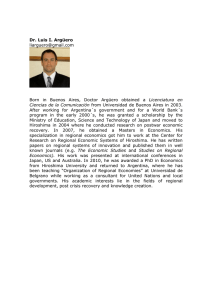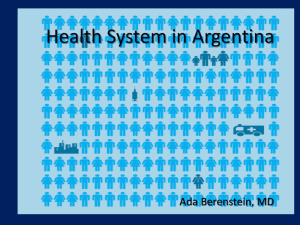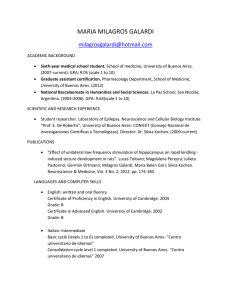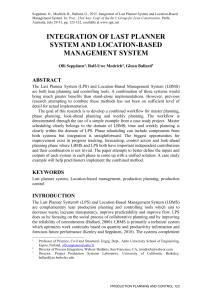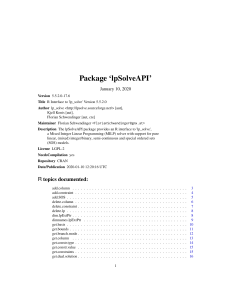DIVERSITY AND DISTRIBUTION OF LICHENS ON MORTAR AND
Anuncio
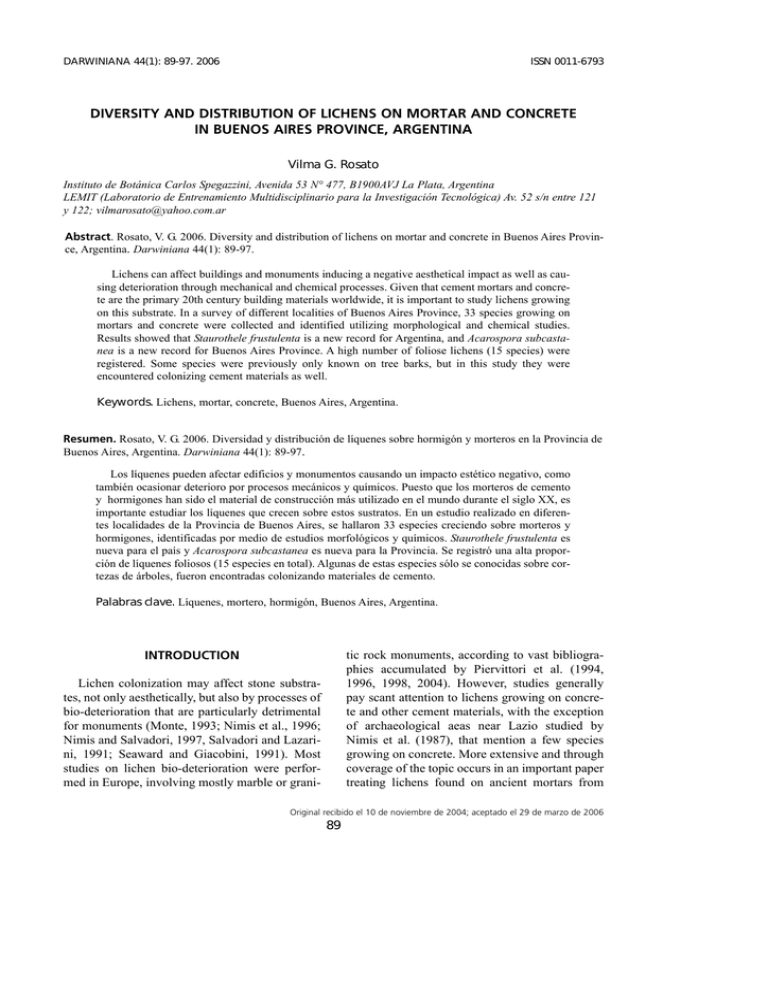
DARWINIANA 44(1): 89-97. 2006 ISSN 0011-6793 DIVERSITY AND DISTRIBUTION OF LICHENS ON MORTAR AND CONCRETE IN BUENOS AIRES PROVINCE, ARGENTINA Vilma G. Rosato Instituto de Botánica Carlos Spegazzini, Avenida 53 N° 477, B1900AVJ La Plata, Argentina LEMIT (Laboratorio de Entrenamiento Multidisciplinario para la Investigación Tecnológica) Av. 52 s/n entre 121 y 122; [email protected] Abstract. Rosato, V. G. 2006. Diversity and distribution of lichens on mortar and concrete in Buenos Aires Province, Argentina. Darwiniana 44(1): 89-97. Lichens can affect buildings and monuments inducing a negative aesthetical impact as well as causing deterioration through mechanical and chemical processes. Given that cement mortars and concrete are the primary 20th century building materials worldwide, it is important to study lichens growing on this substrate. In a survey of different localities of Buenos Aires Province, 33 species growing on mortars and concrete were collected and identified utilizing morphological and chemical studies. Results showed that Staurothele frustulenta is a new record for Argentina, and Acarospora subcastanea is a new record for Buenos Aires Province. A high number of foliose lichens (15 species) were registered. Some species were previously only known on tree barks, but in this study they were encountered colonizing cement materials as well. Keywords. Lichens, mortar, concrete, Buenos Aires, Argentina. Resumen. Rosato, V. G. 2006. Diversidad y distribución de líquenes sobre hormigón y morteros en la Provincia de Buenos Aires, Argentina. Darwiniana 44(1): 89-97. Los líquenes pueden afectar edificios y monumentos causando un impacto estético negativo, como también ocasionar deterioro por procesos mecánicos y químicos. Puesto que los morteros de cemento y hormigones han sido el material de construcción más utilizado en el mundo durante el siglo XX, es importante estudiar los líquenes que crecen sobre estos sustratos. En un estudio realizado en diferentes localidades de la Provincia de Buenos Aires, se hallaron 33 especies creciendo sobre morteros y hormigones, identificadas por medio de estudios morfológicos y químicos. Staurothele frustulenta es nueva para el país y Acarospora subcastanea es nueva para la Provincia. Se registró una alta proporción de líquenes foliosos (15 especies en total). Algunas de estas especies sólo se conocidas sobre cortezas de árboles, fueron encontradas colonizando materiales de cemento. Palabras clave. Líquenes, mortero, hormigón, Buenos Aires, Argentina. tic rock monuments, according to vast bibliographies accumulated by Piervittori et al. (1994, 1996, 1998, 2004). However, studies generally pay scant attention to lichens growing on concrete and other cement materials, with the exception of archaeological aeas near Lazio studied by Nimis et al. (1987), that mention a few species growing on concrete. More extensive and through coverage of the topic occurs in an important paper treating lichens found on ancient mortars from INTRODUCTION Lichen colonization may affect stone substrates, not only aesthetically, but also by processes of bio-deterioration that are particularly detrimental for monuments (Monte, 1993; Nimis et al., 1996; Nimis and Salvadori, 1997, Salvadori and Lazarini, 1991; Seaward and Giacobini, 1991). Most studies on lichen bio-deterioration were performed in Europe, involving mostly marble or grani- Original recibido el 10 de noviembre de 2004; aceptado el 29 de marzo de 2006 89 DARWINIANA 44(1): 89-97. 2006 MATERIALS AND METHODS Lichens were collected mainly in the central and SW part of the Buenos Aires province as well as the southern coast of the Río de la Plata (Fig. 1). The places where samples were obtained are indicated in the following list. Azul: Cemetery (wall of a 1915 funeral monument); “La Cruz” dam. Cacharí: church, wall along the lateral street. Castelli: Bridge over Salado River. Coronel Pringles: Town Hall, terrace walls; lamp column in the main square; slaughterhouse, outside walls. La Plata: Facultad de Agronomía, entrance wall, Plaza Moreno, lamp column; Astronomy observatory, monument in the park; LEMIT building, outside walls; Cemetery; walls of funeral monuments; Priests´ Seminar, outside wall; private house. Lobos: Bridge over route 205, side column. Magdalena: Bridge over “El Pescado” stream; bridge over “Zapata” stream, bridge over “Cañada de Arregui” marsh. (all of these bridges are located along Province Route 11). Olavarría: urban bridges over Tapalqué stream. Pellegrini: church, outside wall. Saldungaray: entrance of the Cemetery. Tandil: walls and windows of an ancient house; monuments of Independencia park; dam. Tornquist: Town hall, outer walls. Verónica: Estancia Luis Chico. Cement statues and benches in the park. Fig. 1. Buenos Aires Province. Dots indicate the localities where lichens were sampled. three archeological sites in Southern Spain (Ariño et al., 1997) Concrete and other cement materials have been the principal building material used since the beginning of the 20th century worldwide. In Argentina and the Province of Buenos Aires are some “artdéco” buildings that are now becoming appreciated and protected as a part of local heritage. Some of these buildings are colonized by lichens as well as other structures such as dams and road bridges, but were not studied until recently. According to the literature examined (Grassi, 1950; Calvelo & Liberatore, 2002), no specific examples were mentioned growing on cement materials, so it is important to know which species are present on cement materials in order to know which ones are potentially harmful for this substratum. The present paper offers a checklist of lichens found on mortar and concrete in the Buenos Aires Province, providing a first contribution to the knowledge of lichens on this special man-made substratum for the province and the country. Each species distribution for the province, local diversity, habit and substrate preferences are discussed. To obtain samples from the vertical walls of the Azul dam, a collaborator using ropes and a safety harness climbed the structure. Lichens were identified utilizing dissecting and optical microscopes. Measurements of thalli, apothecia, hymenium, asci and ascospores were made. Usual histochemical reactions were performed as well as TLC of the foliose exemplars using the technique of Culberson (1972). These data helped to identify the lichens by means of keys (Adler 1988, 1992; Magnusson, 1929), Nimis et al. 1987; Osorio 1977; Ozenda et Clauzade 1970; Poelt 1969; Scutari 1992a, 1992b, 1995). The specimens are deposited at the herbarium 90 V. G. ROSATO. Diversity and distribution of lichens on mortar and concrete in Buenos Aires Table 1. Characteristic and composition of mortars from studied buildings (Data from Rosato, 2001 and Rosato, 2004). Localities Substratum´s age Carbonation Water absoprtion rates (%) Habitat Na Mg Al Si Cl K Ca Fe Ti La Plata (Seminar) Tandil Dam) Cnel. Pringles (Light column) Lobos (Bridge) Saldungaray (Cemetery) 80 + 7,2 Urban 1,47 2,87 16,86 55,81 0,25 4,63 4,41 11,78 - 60 + 7,9-9,3 Urban/rural 5,90 26,24 1,64 62,25 3,97 - 75 + 7,94 Urban 10,28 6,4 5,66 3,48 57,82 5,89 10,46 60 + Rural 3,22 23,45 65,44 7,95 - 75 + Urban 2,99 3,08 15,74 52,15 0,91 4,9 11,42 9,17 - LPS. (http://sciweb.nybg/science2/IndexHerbariorum.asp). Information about the buildings and substratum were also obtained. The locality, age of the building and the kind of habitat are indicated in Table 1. Age is important because it influences the carbonation process, which in turn lowers the pH. A fresh cement mix is highly alkaline (pH = 1213), whereas carbonated mortars have pH below 10 which allows the growth of lichens. Whenever samples were of an adequate size, water absorption rate and pH were studied. Data can be observed in Table 1. The mortars and concrete studied are made with a mixture of normal Portland cement, sand and water in varying proportions which influences the composition and the porosity. Whenever possible, the element composition of the mortars was studied by means of EDAX, and the results are indicated in Table 1. The presence of Cl in the samples from Coronel Pringles and Saldungaray is due to the use of Cl2 Ca to accelerate the evolution of material resistance in pre-cast elements. The Ti found in Coronel Pringles is a residue of white paint. The material from Azul dam is a cement with a pH of 9.9, a density of 2.44, a porosity of 11%, and high alkali content: 0.14% Na2O and 0.18% K2O (Traversa et al., 2001). RESULTS AND DISCUSSION Species ocurrence and geographical distribution During this study 33 species were found. A list of representative source materials for each species is included below: Acarospora murorum A. Massal (as Acarospora commixta H. Magnusson.). ARGENTINA. Buenos Aires: Dpto. Coronel Pringles, Municipalidad, pared de la terraza, cemento blanco 03-Dic-99, V. G. Rosato (LPS 47138). Acarospora subcastanea (Nyl.) Hue. ARGENTINA. Prov. Buenos Aires: Dpto. Coronel Pringles, Municipalidad, 03Dic-99, pared de la terraza, cemento blanco V. G. Rosato (LPS 47139); Dpto. Tandil, Dique, en la baranda, hormigón, 18Feb-00, V. G. Rosato (LPS 47140). Caloplaca cinnabarina (Ach.) Zahlbr. ARGENTINA. Buenos Aires: Dpto. Azul, Dique, pared vertical, hormigón, 20Feb-00, L. P. Traversa y M. Gratón (LPS 447141). Caloplaca citrina (Hoffm.) Th. Fr. ARGENTINA. Buenos Aires: Dpto. Azul, Cementerio, pared de bóveda de 1915, mortero de cemento 03-Dic-99, V. G. Rosato (LPS 47146); Dpto. Olavarría, Puente de calle Necochea, baranda, mortero de cemento 16-Oct-01, V. G. Rosato (LPS 47144); Dpto. Coronel Pringles, Municipalidad, pared vertical, cemento blanco 03Dic-99, V. G. Rosato (LPS 47149); Dpto. Tornquist, Municipio, pared, mortero de cemento 21-Sep-00, V. G. Rosato (LPS 47142): Dpto. Tornquist, Saldungaray, Portal del cementerio, mortero de cemento 01-Abr-98, L. P. Traversa (LPS 47148): Depto. Tandil, Dique, muro de contención (parte superior), 91 DARWINIANA 44(1): 89-97. 2006 hormigón 19-Feb-00, V. G. Rosato (LPS 47147): Dpto. La Plata, Plaza Moreno, columna de luz, cemento blanco 05/10/99 V. G. Rosato (LPS 47189): Dpto. Pellegrini Iglesia, pared, mortero de cemento, L. P. Traversa (LPS 47190). Hyperphyscia viridissima (Müll. Arg.) Scutari. ARGENTINA. Buenos Aires: Dpto. Tandil: Parque Independencia, banco de cemento, mortero de cemento 20-Nov.-99, V. G. Rosato (LPS 46760). Caloplaca holocarpa (Ach.) Wade. ARGENTINA. Buenos Aires: Dpto. Coronel Pringles, Municipalidad, cemento blanco, 03-Dic-99, V. G. Rosato (LPS 47149): Dpto. Azul, Cementerio, pared de bóveda de 1915, mortero de cemento, 03-Dic-99, V. G. Rosato (LPS 47150): Dpto. La Plata, Facultad de Agronomía, mortero de cemento, 30-Sep-99, V. G. Rosato (LPS 47151): Dpto. Tandil, Dique, baranda, hormigón, 19-Feb-00. V. G. Rosato (LPS 47152): Dpto. Magdalena, Ruta 11, Puente Ao. El Pescado, baranda, mortero de cemento 29/06/01, V .G. Rosato (LPS 47201). Lecania erysibe (Ach.) Mudd. ARGENTINA. Buenos Aires: Dpto. Tandil: Dique pared vertical (parte superior), hormigón 19-Feb-00, V. G. Rosato (LPS 47161). Dpto.Verónica: Ea. Luis Chico, banco en el jardín, mortero de cemento 29/06/01 V. G. Rosato (LPS 47205). Dpto Olavarría: Puente sobre calle Necochea, baranda, mortero de cemento 26/10/01 V. G. Rosato (LPS 47203). Dpto. Magdalena: Ruta 11, Puente Ao. Zapata , baranda, mortero de cemento 29/06/01 V. G. Rosato (LPS 47200). Lecanora umbrina (Ach.) Massal. ARGENTINA. Buenos Aires: Dpto. Azul: Cementerio, pared de bóveda de 1915, mortero de cemento 03-Dic-99, V. G. Rosato (LPS 47171). Dpto. Coronel Pringles: Matadero, pared, cemento blanco 03Dic-99, V. G. Rosato (LPS 47173). Dpto. La Plata: Facultad de Agronomía, pared de la entrada, mortero de cemento 30-Sep99, V. G. Rosato (LPS 47172). Dpto. Magdalena: Ruta 11, Puente sobre Ao. Zapata, baranda, mortero de cemento 29/06/01, V.G. Rosato (LPS 47199). Dpto. Verónica: Ea. Luis Chico, sobre banco en el parque, mortero de cemento 29/06/01, V. G. Rosato (LPS 47206). Dpto. Olavaria: Puente sobre calle Necochea, baranda, mortero de cemento 26/10/01, V. G. Rosato (LPS 47202). Dpto. Cacharí: Iglesia, pared lateral 01/03/00, V. G. Rosato (LPS 47194). Caloplaca erythrantha (Tuck.) Zahlbr. ARGENTINA. Buenos Aires: Dpto. Verónica: Ea. Luis Chico, ornamentos, mortero de cemento 29/06/01, V. G. Rosato (LPS 47207). Caloplaca teicholyta (Ach.) Steiner. ARGENTINA. Buenos Aires: Dpto. Tandil, Casa antigua, calle San Martín y 14 de julio, balaustrada del ventanal, mortero de cemento 20Nov.-99 V. G. Rosato (LPS 47153). Candelaria concolor (Dicks.) Stein. ARGENTINA. Buenos Aires: Dpto. La Plata, Casa particular, pared de la terraza, mortero de cemento Leg..: V. G. Rosato (LPS 47154) Catillaria lenticularis (Ach.) Th. Fr. ARGENTINA. Buenos Aires:, Dpto. Tandil: Dique, pared vertical (parte superior), hormigón, 19-Feb-00, V. G. Rosato (LPS 47155). Dpto. Rauch, Puente Ao. El Gualicho, barandas, mortero de cemento 18/02/00, V .G. Rosato (LPS 47191). Lecanora dispersa (Pers.) Sommerf. ARGENTINA. Buenos Aires: Dpto. La Plata: Facultad de Cs. Agrarias, pared de la entrada, mortero de cemento 30-Sep-99, V. G. Rosato (LPS 47166). Dpto. Tandil: Dique, muro de contención (parte superior), hormigón 12 Nov.-99, V. G. Rosato (LPS 4765). Candelariella aurella (Hoffm.) Zahlbr. ARGENTINA. Buenos Aires: Dpto. Tandil: Parque Independencia, juntas de cemento al pie del monumento al General M. Rodríguez 20 Nov.- 99, V. G. Rosato (LPS 47156). Lecanora muralis (Schreb.) Rabenh. ARGENTINA. Buenos Aires: Dpto. La Plata: LEMIT, pared, mortero de cemento, 10-Oct-99, V. G. Rosato (LPS 47169). Dpto. Tandil: Parque Independencia, monolito IGM, pared horizontal, exposición norte, cemento blanco 20-Nov.-99, V. G. Rosato (LPS 47170). Dpto. Azul: Cementerio, pared de bóveda de 1915, mortero de cemento 03-Dic-99, V. G. Rosato (LPS 47168). Dpto. Coronel Pringles: Municipalidad, pared, cemento blanco 03-Dic-99, V. G. Rosato (LPS 47167). Dirinaria picta (Swartz) Clements & Shear: ARGENTINA. Buenos Aires: Dpto. Verónica: Ea. Luis Chico, sobre banco en el parque, mortero de cemento 29/06/01, V .G. Rosato (LPS 47208). Heterodermia speciosa (Wulfen) Trevisan. ARGENTINA. Buenos Aires: Dpto. Azul: Dique, muro de la pasarela, hormigón, 20-Feb-00, L. P. Traversa (LPS 47157). Phaeophyscia chloantha Moberg. ARGENTINA. Buenos Aires: Dpto. La Plata: Seminario, 01-pared, mortero de cemento Jul-99, V. G. Rosato (LPS 47174). Hyperphyscia coralloides ((Lynge) Scutari. ARGENTINA, Buenos Aires: Dpto. Tandil: estatua de niño, mortero de cemento, Parque Independencia, 20- Nov.-99, V. G. Rosato (LPS 47158). Dpto. Azul: Cementerio, muro de bóveda de 1915, mortero de cemento 03/12/00, V. G. Rosato (LPS 47192). Dpto. Olavarria: Puente sobre calle Necochea , baranda, mortero de cemento 26/10/01, V. G. Rosato (LPS 47204). Physcia undulata Moberg. ARGENTINA. Buenos Aires: Dpto. Coronel Pringles: Municipalidad pared, cemento blanco 3-Dic-99, V. G. Rosato (LPS 47176). Dpto. Cacharí: Iglesia, pared lateral, mortero de cemento 03-Dic-99, V. G. Rosato (LPS 47175). Coronel Pringles: Municipalidad, pared, cemento blanco, pared vertical 03/12/00, V.G. Rosato (LPS 47195). Verónica: Ea. Luis Chico, banco en el jardín, mortero de cemento 29/06/01, V. G. Rosato (LPS 47210). Hyperphyscia syncolla (Tuck.) Kalb. ARGENTINA. Buenos Aires: Dpto. Tandil: Parque Independencia, banco de cemento, mortero de cemento 20- Nov.-99, V. G. Rosato (LPS 47159). Dpto. Verónica: Ea. Luis Chico, banco en el sendero al río, mortero de cemento 29/06/01, V. G. Rosato (LPS 47209). Punctelia constantimontium Sérusiaux. ARGENTINA. Buenos Aires: Verónica: Ea. Luis Chico, banco en el jardín, mortero de cemento 29/06/01, V.G. Rosato (LPS 47211). Punctelia subpraesignis (Nyl.) Krog. ARGENTINA. Buenos Aires: Verónica: Ea. Luis Chico, 29/06/01, ornamento, mortero de cemento V.G. Rosato (LPS 47212). Hyperphyscia variabilis Scutari ARGENTINA. Buenos Aires: Dpto.Tandil: Dique, muro de contención (Parte superior), cara aguas arriba, hormigón 18/02/00, V. G. Rosato (LPS 47193). Pyxine berteroana (Fée) Imshaug. ARGENTINA. Buenos 92 V. G. ROSATO. Diversity and distribution of lichens on mortar and concrete in Buenos Aires Hyperphyscia coralloides Scutari. No substances were found for this species previously (Scutari, 1995), but when a TLC analysis was performed during this study, zeorine and triterpenoids were detected. However, I found that it has a thallus appearance and triseptate spores similar to Hyperphyscia coralloides, so it is placed into this species because it is possibly a chemical variety. The crustose species Staurothele frustulenta is recorded for the first time for Argentina, and Acarospora subcastanea, a species known from Chile and Mendoza Province, Argentina, is found to be a new record for the Province. The presence of Pyxine berteroana is very unusual, because it is a tropical or subtropical species. In Buenos Aires Province it has been recorded only from Martin García Island, in the Delta, in the NE of the Province by Scutari (1992). The crustose species, except Acarospora subcastanea, have a wide distribution and are also known from Europe. However, from the 38 species listed by Ariño, & al. (1997) from ancient mortars in Southern Spain, only six are also found in the Buenos Aires Province: Caloplaca citrina, Caloplaca teicholyta, Candelariella aurella, Lecanora albescens, Lecanora dispersa and Sarcogyne regularis There are 10 species in La Plata, 11 in Azul and 18 in Tandil. The most common species there are Caloplaca citrina, C. holocarpa, Lecanora albescens and L. muralis f. Versicolor. The latter 3 are also found in Cacharí and Coronel Pringles, where a total of 3 and 8 total lichen species were found respectively. Conversely, Caloplaca cinnabarina, Heterodermia speciosa, Pyxine berteroana and Xanthoria candelaria are present only in Azul, whereas Caloplaca teicholyta, Candelariella aurella, Catillaria lenticularis, Hyperphyscia syncolla, Hyperphyscia viridissima, Lecania erysibe, Sarcogyne pruinosa and Xanthoria fallax are present only in Tandil. Five species recorded for La Plata have not yet been found in the remaining localitites: Candelaria concolor, Lecanora umbrina, Phaeophyscia chloantha, Teloschistes chrysophthalmus and Xanthoria parietina. In Veronica there are 11 species, including four not found at other study sites: Caloplaca erythrantha, Dirinaria picta, Punctelia constantimontium and Punctelia subpraesignis. Aires: Dpto. Azul: Cementerio, pared de bóveda de 1915, mortero de cemento 03-Dic-99, V. G. Rosato (LPS 47177). Sarcogyne regularis Körber. ARGENTINA. Buenos Aires: Dpto. Tandil: Parque Independencia, Monolito IGM, pared vertical, exposición sur, cemento blanco20-Nov.-99, V. G. Rosato (LPS 47178). Staurothele frustulenta Vainio. ARGENTINA. Buenos Aires: Dpto. Azul: Puente sobre Arroyo; Dpto. Azul, columnas de soporte, hormigón 21-Abr-01, L. P. Traversa (LPS 47179). Dpto. Tandil: Dique, muro de contención, (parte superior) hormigón 19-Feb-00, V. G. Rosato (LPS 47181). Dpto. Lobos: Puente vial sobre ruta 205, columna de soporte, hormigón 01Oct-99, V. G. Rosato (LPS 47180). Staurothele monosporoides Malme. ARGENTINA. Buenos Aires: Dpto. Tandil: Dique, muro de contención (parte superior), hormigón 19-Feb-00, V. G. Rosato (LPS 47182). Teloschistes chrysophthalmus (L.) Th. Fr. ARGENTINA. Buenos Aires: Dpto. La Plata: Casa particular, pared de la terraza, mortero de cemento 12- Febr. 2001, V. G. Rosato, V. G. Rosato (LPS 47183). Xanthoria candelaria (L.) Th. Fr. ARGENTINA. Buenos Aires: Dpto. Azul: Cementerio, pared de bóveda de 1915, mortero de cemento 03-Dic-99, V. G. Rosato (LPS 47184). Dpto. Pirovano: Iglesia, L.P. Traversa (LPS 47196). Dpto. Pellegrini: Iglesia, pared, mortero de cemento, L. P. Traversa (LPS 47197). Xanthoria fallax (Hepp.) Arn. ARGENTINA. Buenos Aires: Dpto. Tandil: Dique, sobre baranda, hormigón 19-Feb00, V. G. Rosato (LPS 47185). Xanthoria parietina (L.) Th. Fr. ARGENTINA. Buenos Aires: Dpto. La Plata: casa particular, pared de la terraza, mortero de cemento, V. G. Rosato (LPS 47186). Dpto. Verónica: Ea. Luis Chico, pie de estatua de cemento, mortero de cemento 29/06/01, V. G. Rosato (LPS 47213). Dpto. Castelli: Arroyo Seco, Puente sobre Río Salado, baranda, mortero de cemento, L. P. Traversa (LPS 47198). Dpto. La Plata: Facultad de Ciencias Naturales, columna de alambrado perimetral, hormigón 01/07/99, V.G. Rosato (LPS 47187). The data from the above list are arranged by geographical locality in Table 2, indicating also the thallus habit for each species. Other samples were also collected in Tornquist, Saldungaray and Pirovano, that were not included in the table, because in all these cases the only lichen species found was Caloplaca citrina. Another sample collected from a bridge across Salado River, Arroyo Seco, Castelli district is Xanthoria parietina, and was also excluded from the table. From a taxonomical point of view, the species listed in Table 2 agree with the morphological and chemical characteristics mentioned in the keys and descriptions. The only exception is the voucher collection LPS 47158, identified as 93 DARWINIANA 44(1): 89-97. 2006 Table 2. List of lichen species found and localities where they have been collected (Cr=crustose; Fo: foliose, Fr: fruticose). Localities Species Habit Acarospora murorum Acarospora subcastanea Caloplaca cinnabarina Caloplaca citrine Caloplaca erythrantha Caloplaca holocarpa Caloplaca teicholyta Candelaria concolor Candelariella aurella Catillaria lenticularis Dirinaria picta Heterodermia speciosa Hyperphyscia coralloides Hyperphyscia syncolla Hyperphyscia variabilis Hyperphyscia viridissima Lecania erysibe Lecanora albescens Lecanora dispersa Lecanora muralis Lecanora umbrina Phaeophyscia chloantha Physcia undulate Punctelia constantimontium Punctelia subpraesignis Pyxine berteroana Sarcogyne orbicularis Staurothele frustulenta Staurothele monosporoides Teloschistes chrysophthalmus Xanthoria fallax Xanthoria candelaria Xanthoria parietina Totals Cr Cr Cr Cr Cr Cr Cr Fo C Cr Fo Fo Fo Fo Fo Fo Cr Cr Cr Cr Cr Fo Fo Fo Fo Fo Cr Cr Cr Fr Fo Fo Fo - La Plata Tandil Azul Cacharí Olavarría X X X X X X X X Cnel. Lobos Pellegrini Magdalena Verónica Pringles X X X X X X X X X X X X X X X X X X X X X X X X X X X X X X X X X X X X X X X X X X X X X X X X X X X X X X X X X X X X X X X X X X X 10 X 18 11 4 Physcia undulata and Heterodermia speciosa were collected only in the central part of the Province. It is also striking that many species were collected in Tandil and Azul compared to other localities, but these towns are situated in a hilly area, with 5 8 1 2 6 11 rocks where lichens occur naturally, so that they are more likely to colonize cement substrates. In Tornquist and Saldungaray, also situated in hilly areas, the specimens studied were collected by non-lichenologists, so these localities will probably also yield rich diversity upon further sampling. 94 V. G. ROSATO. Diversity and distribution of lichens on mortar and concrete in Buenos Aires On the other hand, the only outcrops of calcareous rocks in the Buenos Aires Province are restricted to Sierras Bayas, near Olavarría (Iñíguez Rodríguez, 1999), so this substratum is not widely available for calcicolous species, which prevents the expansion of a calcicolous lichen biota. This could explain why Ariño & al. (1997) found a greater number of those species in the places they studied: 21 in Baelo Claudia, 25 in Carmona and 15 in Italica. Climatic differences do not influence the most commonly distributed lichen species: Lecanora albescens, L. dispersa, Caloplaca citrina and C. holocarpa, but rather substrate porosity and water retention seem to be important for colonization of these species. Staurothele frustulenta, and S. monosporoides were collected only on hydraulic structures and also bridges, indicating they depend on substrate humidity. In those substrata studied, high water absorption rate or porosity were observed. Cement mortars have an alkaline pH. Fresh cement mortars have pH ranging between 12 and 13 but, as the cases here studied are old mortars already affected by carbonation, the pH is 9.8. Substrate and habitat preferences A striking fact is the presence of 12 corticolous species, that now have been observed growing on mortars for the first time: Caloplaca erythrantha, Dirinaria picta, Hyperphyscia coralloides, H. syncolla, H. viridissima, Lecania erysibe, Phaeophyscia chloantha, Physcia undulata, Punctelia constantimontium, Punctelia subpraesignis Pyxine berteroana and Teloschistes chrysophthalmus, whereas in mortars in Spain there are crustose, calcicolous species and only three foliose ones (Ariño et al., op. cit.). It is necessary to clarify that H. syncolla is the only species found growing on rock (Scutari, 1992), whereas the rest usually grow on trees and have not been collected on cement up to now. With respect to Teloschistes chrysophthalmus, it was priorly listed by Osorio (1976) from Punta Lara, 10 km away from La Plata, in the coastal environment of Río de La Plata but not in an urban environment. Additionally, it is a corticolous species and has not been reported growing on mortars up to now according to the literature reviewed. Taking into account the distribution of the species first ecountered and reported to occur on cement, 6 of them were from Verónica, 2 from Tandil and 1 from Azul. Refering to saxicolous species, it is interesting to say that Heterodermia speciosa was also found on asphalt mix. Acarospora subcastanea has always been reported to occur on granite (Magnusson, 1929). This seems quite remarkable, but the pH of this old mortar is moderately basic and not as high as in recent mortar. Additionally, there is presence of sand aggregates, so this is probably a suitable habitat for this species. Thallus habit It is possible to observe a special distribution of the species according to their thallus habit. In Coronel Pringles and Magdalena only crustose species were found. La Plata is the only locality with a fruticose lichen species. Regarding the number of foliose lichens, they are represented in the locality of Azul by 4 species, in Tandil with 5 species whereas La Plata has 3 foliose species. Cacharí, Olavarría and Coronel Pringles only have one species each. There are no foliose species in the rest of the localities. This is 15 foliose species in total, which means 45,45% of the lichen species found in this study and differs greatly with the data of Ariño et al (1997), who found only three foliose species and no fruticose species. CONCLUSIONS On cement mortars and concrete in the Buenos Aires Province 33 lichen species are able to grow. Among these species, Staurothele frustulenta was found as a new record for the country and Acarospora subcastanea was added to the lichen biota of the Province. Fifteen species (45,45%) are foliose, which is interesting because in the literature examined there are no records of such a high percentage of foliose species. Cement mortars and concrete were shown to 95 DARWINIANA 44(1): 89-97. 2006 support the growth of species only known as corticolous up to now. This is attributed to the environmental conditions (shadow and humidity) because this was observed mainly in rural areas and parks. A greater local diversity of species was noted from localities in the hill areas in the center of the Province, as well as localities on the coast of Río de La Plata. Magnusson, A. H. 1929. A monograph of the genus Acarospora. Kongl. Svenska Vetenskapsakad. Handl. 7: 1400. Monte, M. 1993. The influence of environmental conditions on the reproduction and distribution of epilithic lichens. Aerobiologia 9: 169-179. Nimis, P. L., M. Monte & M. Tretiach. 1987. Flora e vegetazione lichenica di aree archeologiche del Lazio. Stud. Geobot. 7: 3-161. Nimis, P .L., D. Pinna & O. Salvadori. 1996. Licheni e conservazione dei monumenti. CLUEB, Bologna. Nimis P. L. & O. Salvadori. 1997. La crescita dei licheni sui monumenti di un parco. Uno studio pilota a Villa Manin. In E. Accornero (ed.), Il restauro delle sculture lapidee nel parco di Villa Manin a Passariano. Il viale delle Erme, pp. 109-141. Quaderni di studi e ricerche del Centro regionale di restauro dei beni culturali 4. Osorio, H. S. 1976. Contribution to the lichen flora of Argentina VIII. Lichens from Punta Lara, Buenos Aires Province. Bryologist 79: 358-360. Osorio, H. S. 1977. Apuntes de liquenología y clave para los géneros de líquenes de los alrededores de Buenos Aires. Sociedad Argentina de Botánica, Notas Botánicas 1. Ozenda, P. & G. Clauzade, 1970. Les Lichens. Étude biologique et flore illustreé. Masson et Cie., Paris. Piervittori R., O. Salvadori & D. Isocrono. 1998. Literature on lichens and biodeterioration of stonework III. Lichenologist 30: 263-277. Piervittori R., O. Salvadori & D. Isocrono. 2004. Literature on lichens and biodeterioration of stonework IV. Lichenologist 36: 145-157. Piervittori, R., O. Salvadori & A. Laccisaglia. 1994 Literature on lichens and biodeterioration of stonework I. Lichenologist 26: 263-277. Piervittori, R., O. Salvadori & A. Laccisaglia. 1996. Literature on lichens and biodeterioration of stonework II. Lichenologist 28: 263-277. Poelt, J. 1969. Bestimmungschlüssel der europäischen Flechten. Cramer, Lehre. Rosato, V. G. 2001. Degradación del hormigón por acción liquénica. Actas de la Reunión de la Asociación Argentina de Tecnología del Hormigón, Olavarría, 25-26 de octubre de 2001, Tomo I: 97-103. Rosato, V. G. 2004. “Acción del liquen Staurothele frustulenta Vainio sobre sustratos cementíceos”. Ciencia y Tecnología del Hormigón 11: 19-22. Salvadori, O. & L. Lazzarini. 1991. Lichen deterioration on stones of Aquileian monuments (Italy). Bot. Chron. 10: 961-968. Scutari, N. C. 1992. Estudios sobre Pyxinaceae foliosas (Lecanorales, Ascomycotina) de la Argentina IV: Clave de los géneros y las especies de la Provincia de Buenos Aires. Bol. Soc. Argent. Bot. 28: 169-173. Scutari, N. C. 1995. Los macrolíquenes de Buenos Aires, I: Dirinaria, Heterodermia e Hyperphyscia (Physciaceae, Ascomycotina). Darwiniana 33: 149176. ACKNOWLEDGEMENTS These results were partially presented at the Symposium: “Lichen biodeterioration. Progress and Problems”, held at Albuquerque (USA), August 12-17, 2001. I am indebted to Dr. L. St. Clair for his kind invitation, and I must also thank the Samuel Kress foundation for the grant to cover my travel expenses. A special acknowledgement to M. Gratón, who obtained the samples from the vertical walls of the Azul dam, and many thanks to Beatriz Pion and Janice Saunders for the language revision. This work was partially funded by CONICET and CIC. BIBLIOGRAPHY Adler, M. T. 1988. La familia Parmeliaceae (Liquenes, Ascomycotina) en la Provincia de Buenos Aires: estudio taxonómico y florístico. Tesis, Facultad de Ciencias Exactas y Naturales, Universidad Nacional de Buenos Aires. Adler, M. T. 1992. Clave de los géneros y las especies de Parmeliaceae (Lichenes, Ascomycotina) de la Provincia de Buenos Aires (Argentina). Bol. Soc. Argent. Bot. 28: 11-17. Ariño, X., A. Gómez-Bolea & C. Saiz-Jiménez. 1997. Lichens on ancient mortars. International Biodeterioration and Biodegradation 40: 217-224. Calvelo, S. & S. Liberatore. 2002. Catálogo de los líquenes de la Argentina [Checklist of Argentinean Lichens]. Kurtziana 29: 7-170. Culberson, C. F. 1972. Improved conditions and new data for the identification of lichen products by a standardized thin-layer chromatographic method. J. Chromatogr. 72: 113-125. Giacobini, C. & M. R. D. Seaward. 1991. Licheni e monumenti: studi in Veneto e in Puglia. In Atti Convegno Le pietre nell’architettura struttura e superfici, pp. 215224. Bressanone. Grassi, M. M. 1950. Contribucion al catalogo de liquenes argentinos, I. Lilloa 24: 5-296. Iñiguez Rodríguez, A. M. 1999. La cobertura sedimentaria de Tandilia. In R. Caminoa (ed.), Geología Argentina, pp.101-106. SEGEMAR, Buenos Aires. 96 V. G. ROSATO. Diversity and distribution of lichens on mortar and concrete in Buenos Aires Scutari, N. C. 1995. Los macrolíquenes de Buenos Aires, II: Phaeophyscia, Physcia y Pyxine (Physciaceae, Ascomycotina). Darwiniana 33: 211-231. Traversa, L. P., V. G. Rosato, C. A. Pittori & S. Zicarelli. 2001. Biological studies on a concrete dam. Materials and Structures 34:502-505. 97

